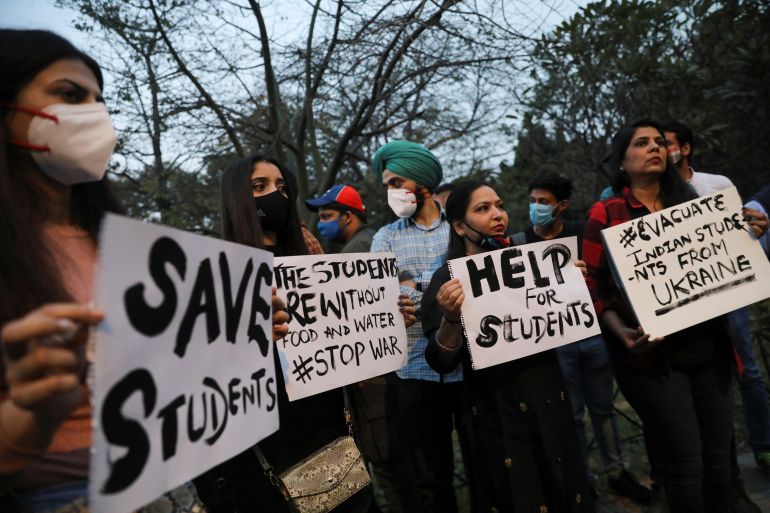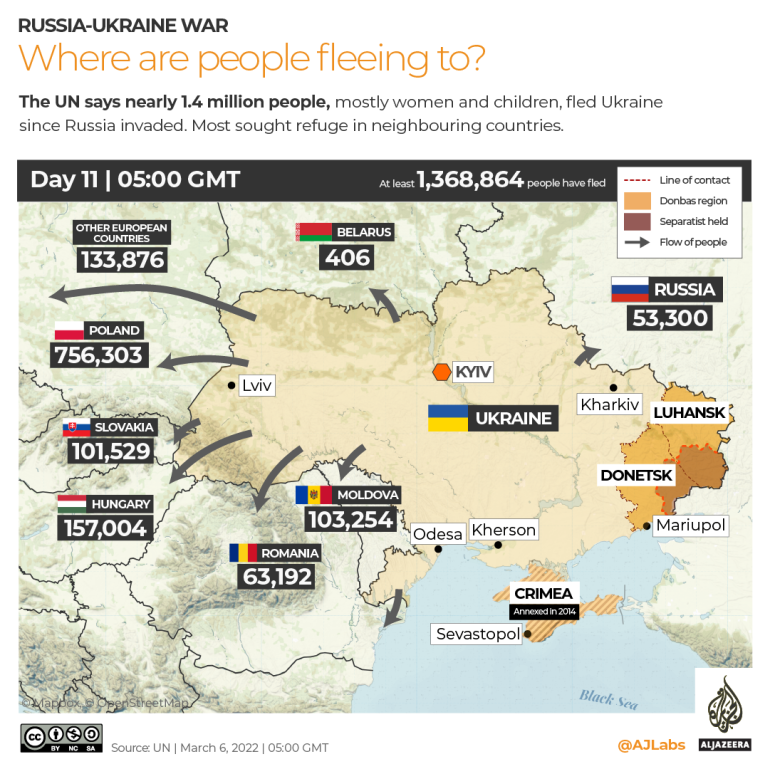Kashmir students recount harrowing journey to escape Ukraine
Kashmiri students tell of frightening ordeal in which they hid in bunkers and basements before reaching safety.

Srinagar, Indian-administered Kashmir – Bhat, a young medical student from Indian-administered Kashmir studying in the Ukrainian city of Kharkiv, woke to the sound of deafening thuds on February 24.
By the time he could gather his thoughts, another loud explosion shook his building, sending Bhat, who requested to be identified by his second name, on a terrifying journey. He spent nights in underground bomb shelters, metro stations, and undertook a dangerous trip through parts of Ukraine under Russian attack.
Keep reading
list of 4 itemsUkraine war: Indian students overcome adversity to reach Romania
Putin, Modi discuss plight of Indian students trapped in Ukraine
Indian students trapped in Ukraine as Russian invasion unfolds
The fourth-year medical student at the Kharkiv Institute of Medicine and Biomedical Sciences escaped the decades-old conflict in Kashmir to study in the relatively safe atmosphere of Ukraine – until everything changed within hours last week.
“We came here with a lot of dreams and hope. We came here to be safe,” Bhat, a resident of the southern district of Anantnag, told Al Jazeera in a phone interview. He is now in the Polish border city of Rzeszow in a shelter provided by the Indian embassy, along with hundreds of Indian students. They are scheduled to be flown to India in the next 24 hours.
Bhat says initially, officials at his university kept assuring he and other students that the situation would be fine. But after spending five days in the trouble-racked Kharkiv region, they were shaken by the killing of an Indian student in shelling just 500 metres from his apartment.
More than 1.3 million people, including foreigners, have fled Ukraine since Russia launched its military operation on February 24.
More than 200 civilians have been killed and 525 wounded, according to the UNHCR. The UN refugee agency warned that it could become the “biggest refugee crisis this century”.

“For five days, we kept on shifting to the building basement whenever there was shelling. For one night, we lived in the metro basement. But then we decided to leave and boarded a bus to the train station,” Bhat said, adding that the journey from Kharkiv to the Polish border, which is nearly 2,800km (1,740 miles), took them an exhausting 22 hours.
“The journey was frightening. When we reached the border, we were made to wait 12 hours in the freezing cold by the Ukrainian officials because they preferred Ukrainian nationals first. A few students fainted due to hypothermic shock,” Bhat recalled.
The Kashmiri student said that Indian officials provided assistance, only after they reached Poland. Students, he said, had to manage their own escape to safety. Indian embassy officials are now providing transport, shelter and food to stranded students, he said.
“We saw death closely. We crossed through the two worst cities, Kharkiv and Kyiv, amid the shelling. It was risky to flee,” he said, adding that he was among 12 Kashmiri students along with hundreds of others who escaped to the Polish border.
“I haven’t slept for the last eight days,” he said.
Kharkiv, east of the capital Kyiv, has come under heavy Russian fire, with thousands of civilians caught up in shelling.
Of the nearly 80,000 international students in Ukraine, nearly 20,000 are from India, including about 200 from Kashmir.
Indian officials on Friday said so far they have taken 18,000 Indians into safe zones in neighbouring countries.
Nasir Khuehami, who heads Jammu and Kashmir Students Association, told Al Jazeera that while most of the students have been evacuated to safe zones, some were still stranded in the Sumy oblast of northeastern Ukraine.
Of the 700 Indian students still stuck in Sumy, which is under heavy fire, 10 are from Kashmir.
“I have spoken to them last night. There was a huge explosion near the students’ hostel. Everyone is frightened and anxious,” Khuehami said.
He said the students were suffering due to power outages and water supply disruption.
“The students took ice from outside their hostels and are melting it for drinking as there is no water available,” he said.
The students, in a video message shared widely on social media, said that it was almost impossible for them to travel to any neighbouring country like Romania, Hungary or Poland without official assistance.
Many who managed to reach home recall frightening experiences.
Sadiq Ahmad, 23, (who requested his name be changed), a second-year medical student from Kashmir’s capital Srinagar, was flown to New Delhi on Friday after he and three friends reached the Romanian border.
Ahmad, who was studying in the city of Ternopil, said that he and his companions had to travel 250km (155 miles) by bus to reach the safe zone on the Romania-Ukraine border.
“Our university informed us to leave immediately. There was a lot of panic. We were terrified and our families were anxious back home after watching the news,” Ahmad told Al Jazeera.

On reaching the Romanian border, Ahmad said the students were made to wait for more than nine hours before they could cross.
“There were only two gates and thousands of people were struggling to cross. On reaching Romania, the local residents assisted us and provided us with all kinds of help. They were really kind,” Ahmad said.
However, students such as Basit (name changed) who started his medical course this month, fear for an uncertain future.
“I reached my university from Kashmir on February 21 after travelling for 32 hours. After two days, the bombing started,” Basit, a first-year student at Kharkiv National Medical University, said.
“I lived with my friends and on the night of February 24 heavy shelling started. We moved from our apartment and rushed to bunkers,” he said, adding that he, along with his friends, ran out of food and could not buy anything from supermarkets.
“The shelves at the supermarket were empty. It made our life miserable. The next day, we planned to leave but all the streets were empty and firing was going on,” he said.
Basit says a group of students managed to escape to the Kharkiv train station from where they took a train to Odesa – the only escape route they could think of. They finally took another train to reach Palanca in Moldova.
“We stayed at the Moldova centre place. From there, we went to Romania after which we were flown to Delhi by the government,” Basit said.
“It felt like we left Kashmir to flee conflict and it followed us.”